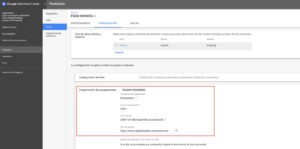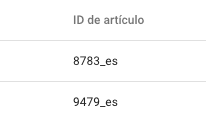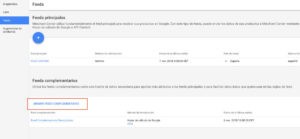Cómo potenciar mis Campañas de Shopping
Lo primero que debemos de tener claro es que, para crear Campañas de Shopping, hemos de subir un feed de datos a Google Merchant Center.
Por lo tanto, cuanto más completo sea este feed de datos, más oportunidades de venta estaremos creando en nuestras Campañas de Google Shopping, o lo que es lo mismo, estaremos potenciando la visibilidad de nuestras Campañas de Shopping.
Antes de nada, ¿Qué debemos saber?
A. Tiempo de renovación del feed
Normalmente Google pide que actualices el feed 1 vez al día, personalmente recomendaría que esto se efectuara de forma automática en la madrugada, para automatizar un poquito el proceso pero tener margen de reacción en el caso de que este fallara.
B. El ID de producto
Este apartado es fundamental y muchas veces no le damos la importancia que debería. Cada producto debe tener un ID único, por lo que debemos usar IDs distintos para diferentes colores del mismo producto, distintos modelos de la misma marca, etc. No es recomendable reutilizar ID, aunque el producto ya no esté disponible.
C. Feeds Complementarios
Es posible que vuestro feed de productos sea tan extenso que se complique a la hora de modificarlo directamente o continuamente, para esto existen los feeds complementarios. Estos te ayudarán a enriquecerlo, incluyendo datos adicionales a los de tu feed principal; descripciones, imágenes, url móvil, etc. Pero ojo, hay que tener en cuenta que este tipo de feed no puede ser utilizado como fuente principal de datos.
Y ahora, ¿Cómo podemos mejorar el feed?
1. Título y Descripción
Es muy importante que entre estos campos del feed de Google Shopping aparezcan todos los términos relevantes, pero con cierta jerarquía.
Por ejemplo, que en Título salga; el término el nombre del producto; si se trata para hombre o para mujer, la talla, el color, modelo, cuanta más información mejor.
En la Descripción salgan todos los demás términos relevantes para los que queremos que salga esa pieza, y sobre todo utilizar sinónimos para ayudar a Google a comprender qué estamos vendiendo. Esta debe ser lo más completa posible y dispone de hasta 5000 caracteres. Seguramente los títulos se queden cortos en algunos casos y ciertos atributos del producto tendrán que bajar a este nivel.
2. Disponibilidad
No recomendaría enviar productos al feed sin stock, pero entiendo que hay algunos tipos de productos que se venden o se encargan bajo demanda. En cualquier caso, debemos de indicar siempre si el producto está disponible o no.
3. Imágenes de calidad
Al igual que pasa con las descripciones, la imagen puede llegar a diferenciarnos del resto de nuestros competidores por lo que, ampliar el catálogo de imágenes o mejorar la calidad de estas, puede llegar a diferenciarnos.
4. Sale Price y Price
Deberíamos de tener activo únicamente el Price, y dejar el Sale Price para realmente momentos de promociones o rebajas, como Black Friday, Rebajas de Enero, etc.
Además para utilizar el Sales Price hay unos requisitos muy concretos que podemos consultar aquí.
5. Google Product Category
Por un lado, solo se puede poner una categoría por producto, de Google Product Category, y es obligatorio hacerlo. Por ejemplo:
Ropa y accesorios > Complementos [Gafas de Sol] (178)
6. Parámetros de Descripción Detallada de Productos
En este apartado es recomendado añadir todos los posibles a todos los productos; age_group y gender, color, gender, material, pattern, size, size_type, etc.
Cuanto más completo, más fácil será que os encuentren, más precisas serán las búsquedas que lleguen y más probabilidad tendremos de ser mejores que la competencia y se nos recompense por ello.
7. Custom_label // etiqueta_personalizada
Para aumentar la oportunidad de éxito, es muy importante que se configuren los Custom Labels. Como el nombre indica, estos custom labels no son otra cosa que etiquetas que podemos introducir en el feed, y que posteriormente, pueden ayudar en la creación de estructuras de forma que nuestras campañas de shopping puedan optimizarse según categorías, temporalidad/estacionalidad, rendimiento del producto, competitividad del producto, etc.
8. Envío
Y para finalizar, simplemente recordar que poner el precio de envío es obligatorio, por lo que si tenemos Envío Gratuito deberíamos elegir la opción de Tarifa Fija y luego a la hora de introducir un importe al ser envío gratis indicar “0”.
Por último, una vez hayamos afinado todos estos parámetros, podremos ver el verdadero potencial de nuestras Campañas de Shopping.
Pero CUIDADO, como el feed es un archivo en continuo movimiento, nos encontraremos con la posible aparición de errores de: gtin, políticas de google, conflictos de precio, errores de url, etc. Por lo que, deberemos estar siempre muy atentos a nuestro Google Merchant para solucionar y tener nuestro feed de datos lo más óptimo posible.









